Related Research Articles

Cuanza Sul Province is a province of Angola. It has an area of 55,660 square kilometres (21,490 sq mi) and a population of 1,881,873. Sumbe is the capital of the province. Dom Francisco Inocêncio de Sousa Coutinho founded the province in 1769 as Novo Redondo.

Malanje is a province of Angola. It has an area of 97,602 km² and a 2014 census population of 986,363. Malanje is the provincial capital.

Volcanoes National Park is a national park in northwestern Rwanda. It covers 160 km2 (62 sq mi) of rainforest and encompasses five of the eight volcanoes in the Virunga Mountains, namely Karisimbi, Bisoke, Muhabura, Gahinga and Sabyinyo. It borders Virunga National Park in the Democratic Republic of Congo and Mgahinga Gorilla National Park in Uganda. It is home to the mountain gorilla and the golden monkey, and was the base for the primatologist Dian Fossey.
Porto Amboim is a port town in Cuanza Sul Province, Angola with a population of 65,000; it comprises an area of 4,638 km2. In the past Porto Amboim was connected by an isolated 123 km 610 mm narrow gauge railway to Gabela, albeit closed in 1987 due to the civil war and to the abandonment of most coffee plantations, the biggest source of revenue from Gabela. Originally Porto Amboim was known as Kissonde, a small village later colonized in 1587 by the Portuguese naming it Benguela and later Benguela Velha due to the creation of another village today known as Benguela located 350 km south of Benguela Velha. In 1923, the name was changed to Porto Amboim. Today (2014) Porto Amboim is one of the growing areas for the offshore industry. The pre-salt in front of the coast of Angola, with Porto Amboim in the centre is a planned development area. With companies as Paenal, a joint venture between Sonangol, SBM and DSME and Heerema Porto Amboim, the two major offshore fabrication yards, Porto Amboim is developing.

Kainji National Park is a national park in Niger State and Kwara State, Nigeria. Established in 1978, it covers an area of about 5,341 km2 (2,062 sq mi). The park includes three distinct sectors: a part of the Kainji Lake in which fishing is restricted, the Borgu Game Reserve to the west of the lake, and the Zugurma Game Reserve to the southeast.

The Malagasy or striped civet, also known as the fanaloka or jabady, is an euplerid endemic to Madagascar. It is the only species in genus Fossa.

The wildlife of Angola is composed of its flora and fauna.
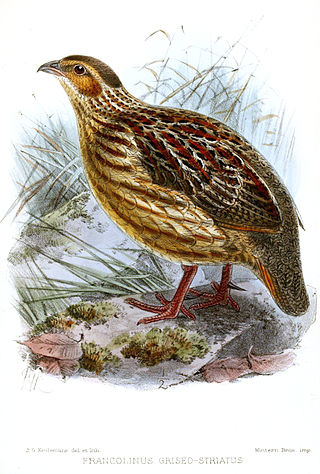
The grey-striped spurfowl is a species of bird in the family Phasianidae. It is found only in Angola.
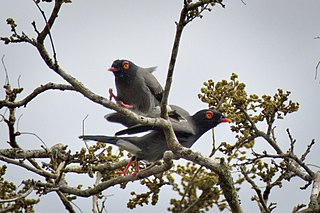
The Gabela helmetshrike is a species of bird in the Vanga family Vangidae, formerly usually included in the Malaconotidae.

The Gabela akalat is a species of bird in the family Muscicapidae. It is endemic to Angola. The name is in part derived from the town where they were first observed, Gabela.

Black River Gorges National Park is a national park in the hilly south-western part of Mauritius. It was proclaimed on June 15, 1994 and is managed by the National Parks and Conservation Service. It covers an area of 67.54 km² including humid upland forest, drier lowland forest and marshy heathland. Facilities for visitors include two information centres, picnic areas and 60 kilometres of trails. There are four field stations in the park which are used for National Parks and Conservation Service and Mauritian Wildlife Foundation research and conservation projects.
Gabela is a town, with a population of 116,903 (2014), and a commune, named Gabela Sede, in the municipality of Amboim, province of Cuanza Sul, Angola and the seat of that municipality. The area of the commune comprises 459 km2 with a population of 184,723. It was founded as N'Guebela on September 28, 1907.

The tourism industry in Angola is based on the country's natural environment, including its rivers, waterfalls and coastline. Angola's tourism industry is relatively new, as much of the country was ravaged during the post-colonial civil war which ended in 2002. Unlike most countries in the region, which generally give US, EU, and many other citizens a visa on arrival or require no visa at all, Angola has complicated visa requirements. This procedure towards visitors places the country at a disadvantage in the competitive international tourism market.
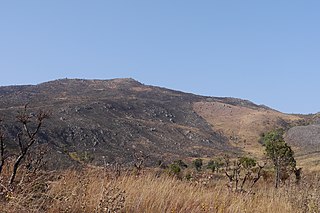
Mount Moco, at 2,620 metres (8,600 ft), is the highest mountain in Angola. It is located in Huambo Province in the western part of the country, 70 kilometres (43 mi) west of the city of Huambo. Mount Moco was named one of Angola's "seven wonders" in 2014. The mountain is a destination for birdwatchers, hikers, and people participating in rappelling and paragliding.

The Angolan Scarp savanna and woodlands is an ecoregion located on the coast of Angola, an area with a variety of habitats and rich in wildlife including many endemic birds and animals.

Pico do Príncipe is a mountain on the island of Príncipe, the smaller of the two inhabited islands of São Tomé and Príncipe. The elevation of the mountain is 947 metres (3,107 ft), making it the highest peak on the island. The island is one of the volcanic swells that make up the Cameroon line of extinct and active volcanoes.
Amboiva is a town and commune in the municipality of Seles, province of Cuanza Sul, Angola. It is roughly 55 kilometres east of Uku and 80 kilometres southeast of Gabela. It lies at an altitude of 1244 metres.
The Longa is a river in central Angola. The river forms the southern border of Kissama National Park and the border of Bengo Province and Cuanza Sul Province. Its mouth is protected by a long sand spit at the Atlantic Ocean. It has two major tributaries, Nhia and Mugige. The floodplain in the lower reaches of the river includes Lake Hengue and Lake Toto.
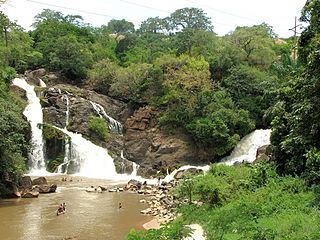
The Cuvo is a river in central Angola. The river mouth is at the Atlantic Ocean at Benguela Bay, in Cuanza Sul Province. Cuvo is its name in its upper reaches; its lower course is called the Keve or Queve. The river is navigable upstream to Binga Falls near Gabela.
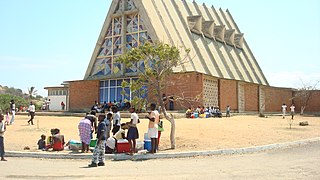
The Our Lady of the Conception Cathedral also called Sumbe Cathedral Is the name given to a religious building belonging to the Catholic Church located in the city of Sumbe in the province of Cuanza Sul, west of the African country of Angola. As its name indicates it is dedicated to the Immaculate Conception of the Virgin Mary.
References
- ↑ "Articles - Kumbira Forest | Bradt Travel Guides". www.bradtguides.com. Retrieved 2018-10-17.
- ↑ Stead, Mike; Rorison, Sean (2010-01-26). Angola. Bradt Travel Guides. ISBN 9781841623047.
- ↑ "Tracks4Africa". Tracks4Africa. Retrieved 2018-10-17.
- ↑ Gonçalves, Francisco Maiato Pedro; Goyder, David John (2016-06-15). "A brief botanical survey into Kumbira forest, an isolated patch of Guineo-Congolian biome". PhytoKeys (65): 1–14. doi: 10.3897/phytokeys.65.8679 . ISSN 1314-2003. PMC 4957018 . PMID 27489484.
- ↑ "Conserving Angolan scarp forests: a holistic approach for Kumbira Forest - Conservation Leadership Programme". Conservation Leadership Programme. Retrieved 2018-10-17.
- ↑ "eBird--Kumbira Forest Reserve". eBird. Retrieved 2018-10-17.